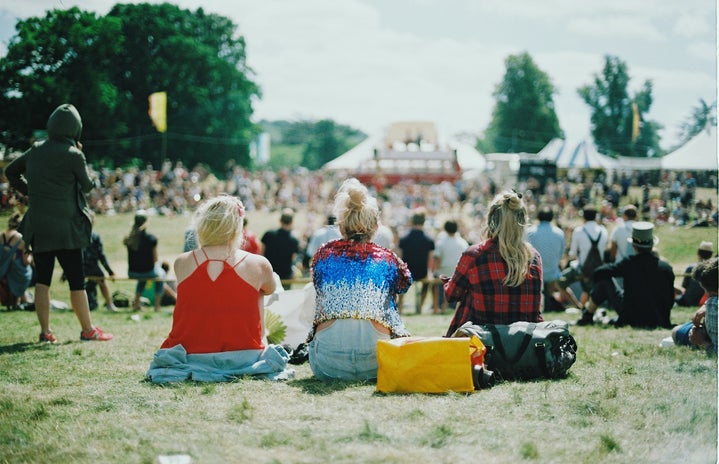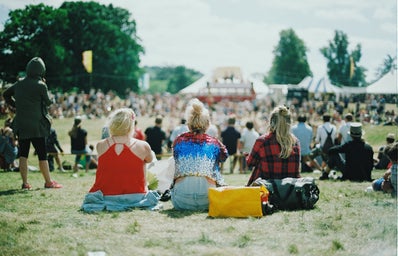By: Aubrey Decker
Between Lollapalooza, Coachella, All Things Go, and Gov Ball, music festivals (although classic) are becoming trendier than ever.
Music festivals are a great way to see live music as they are essentially back-to-back concerts, meaning you get multiple performances for the price of one. That being said, there are some major differences between the two that attendees have to keep in mind when preparing for a festival. What you wear and carry on your person, hydration, and safety plans are all super important to ensure you get the most out of your experience at a festival.
1. Hydration
Hydration might seem like an obvious factor when preparing for a music festival, but it’s common for people to underestimate just how much water they need. Staying hydrated helps your body regulate its temperature and produce sweat as dehydration can take its toll on your body both mentally and physically.
When you’re at a music festival, you’re often walking around from stage to stage, hopefully dancing a little, too. There’s not much sitting down at festivals, meaning you are out in the elements with minimal shade, exerting energy. The CDC recommends drinking one cup, or eight ounces, of water every 15-20 minutes when working in the heat.
Although most festivals offer reusable or disposable water bottles through vendors, a hydration pack or backpack can be a great way to reduce waste and increase your water intake. A hydration backpack is a backpack that has a refillable bladder within the bag cavity that attaches to a tube for easy water access. Most festivals will have hydration stations throughout the venue for refilling. Brands like Teton Sports, Camelbak, and Dicks Sporting Goods all sell variations of hydration backpacks, but you could also shop second-hand or borrow from a friend.
2. Bags and Backpacks
Another important thing to consider as you prepare for your festival is the bag policies at the venue. For bigger festivals, such as Lollapalooza (IL) and Gov Ball (NY), clutches and fanny packs smaller than 6” by 9” are allowed. Bags larger than 6” by 9” must be clear and smaller than 12” by 6” by 12”. The majority of festivals allow hydration backpacks regardless of size that are not required to be clear, but it is always a good idea to double-check and confirm before arriving at the venue. Any venue you enter for a festival will search your bags, so be sure to check out the respective information pages on prohibited items when you pack your bags. Some examples of prohibited items from All Things Go (MD) include outside beverages and alcohol, glass, weapons, and professional cameras.
3. Safety
Safety is another important thing to plan, regardless of whether you attend a festival solo or in a group.
Festivals will publish maps of the venues, including the stages, restrooms, medical tents, food and drink vendors, exits, and more. Festivals are very crowded; in fact, Lollapalooza had around 400,000 attendees in 2023! Between the crowds and the bustling nature of the festival, it is very possible to get separated from your group. More so, when going to festivals in a group, overlapping and conflicting set times can mean people want to see different artists at the same time, resulting in splitting up.
Many venues have spotty cell phone reception, so a great way to avoid the stress of losing a friend is to select a predetermined, designated meet-up spot. Whether it’s your favorite food vendor or the merchandise tent, knowing exactly where to go if you get separated from your group can make a big difference in your experience. Using the same maps you use to designate your meet-up location, check out where the medical tents, hydration stations, and entry/exit points are to ensure you are equipped for anything that comes up.
4. Fashion
Last but not least, what you wear will majorly impact your festival experience. Fashion might be the most important thing on attendees’ minds as they prepare, but there are many factors to consider when crafting a festival ‘fit.
Although some might argue that beauty is pain, comfort is strongly suggested to fall higher on your list for outfit criteria. Many festivals occur during the warmer months, and the venues might not always have ample shady spots to cool down. You will be walking around all day, potentially carrying a backpack or fanny pack, dancing, and sweating in whatever you choose to wear, so keep those elements in mind. It’s also smart to look at the weather for both morning, mid-day, and evening as you select your outfit. The choice you make when it’s 75 degrees in the morning might not be the same choice you would make when you remember it will be 50 degrees at night.
Footwear is also critical when it comes to staying comfortable and enjoying your time at a festival. Walking from stage to stage is a big element of festivals, as well as prolonged periods of standing and dancing at each of the performances. Mosh pits or even large, jostling crowds could result in people stepping on each other’s feet. Additionally, any rain or moisture might lead to muddy patches by the end of the festival, so closed-toe shoes are recommended.
What’s most important is that you feel cute and comfortable while you enjoy live music!
Overall, music festivals can be a great experience when you’re well-prepared. Staying hydrated, dressing appropriately for the weather and activity level, knowing the festival guidelines, and following good safety practices are a surefire way to make the most of your festival experience!


